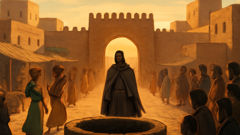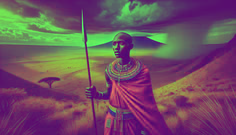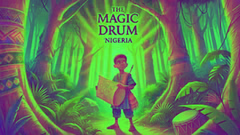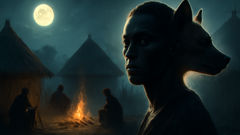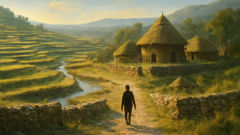Introduction
The story begins where river dust meets sun, in the heat-worn markets and almond-colored walls of towns that would become the heart of Hausa memory. Bayajidda arrives as strangers always arrive in the oldest stories: with a bundle, a secret, and a skill. He is not described as a conqueror at first but as a traveler, a man whose speech and sandals are foreign and whose eyes keep the look of the road. Yet the people of the town of Daura sense that his arrival will break the rhythm of their days. Before his coming, the town answers to a different rhythm entirely—one set by a terrible thing that lived in the well at the center of town, a thing the elders name with a hush and a side-glance. The serpent, so the tale goes, claimed the water that sustained the market and the granaries, and the women of Daura paid the price: each day one of them carried the pail to the chained opening and offered herself to the serpent, to spare the others. This practice made kings of silence and queens of sorrow; it taught courage to some and despair to others. In the years the myth reaches back to, the queen of Daura sits with a crown of heavy gold and a face that knows the geometry of long sorrow. She is the one who meets Bayajidda not merely as ruler but as guardian of a people's wounded dignity. And Bayajidda, with a past both hinted and hidden, steps into the town like a question in a language everyone wants answered. In this retelling I bring scenes to life: the grit of the well rim, the gleam of a sword fashioned far from the Sahel, the small brave conspiracies of women who plan, and the hush before a fight that will be remembered for generations. This is neither a dry chronicle nor a cropped myth; it is an attempt to let the voices of Daura and the surrounding Hausa states be heard as living, breathing things—stories braided with the scents of millet cooking, the creak of wooden doors, the echo of praise-singers' voices, and the stiffness of rulers trying to keep order when a stranger arrives with intentions that are as generous as they are dangerous.
Arrival, Rumors, and the Stranger's Past
The road that brought Bayajidda to the edge of Daura was an old one. It braided across savannah and shale, carried by seasons and the memory of traders who came with kola and cowrie. In the mornings the air tasted of dust and coffee; in the evenings it swelled with the lowing of cattle and the careful speeches of elders. Bayajidda's footsteps are recorded in the mouths of many towns: he passed through towns where the market smelled of tamarind and roasted millet, through villages where children chased goats, through kingdoms whose rulers measured time by the cost of horses. He is a figure of motion, a man who could not be pinned down to a single origin in the memory of storytellers. Some say he came from Baghdad, some say from the coast to the south, others insist he arrived from the north, where the dunes slide into a horizon of iron sky. The multiplicity of claims is itself a part of the myth: Bayajidda belongs everywhere and nowhere, a cipher that invites a people to imagine the doorway to their own beginning.
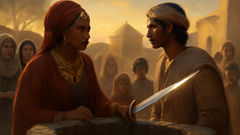
When he reached Daura the gates were not closed against travelers. The gatekeeper, an old man with the patience of rusted chain, accepted his modest fee, glanced at the sword, and nodded. He did not suspect that sword would become history. In Daura the well marked the town's center—stone narrow and ancient and oozing a myth that had hardened into law. The serpent ruled that well. It is worth saying plainly what the myth refuses to gloss over: the serpent was not merely a monster in the way pests or wild cats are monsters. It was a presence that demanded tribute and offered, in return, silence. Each day the women of Daura took turns lowering the bucket and leaving the well to its appetite; each day they hoped to be spared. The queen, who wore her crown with the stiffness of a woman who had learned more rules than songs, kept her own counsel but could not stop the custom. In truth, the serpent's coercion was a political device as much as a supernatural threat—a way for those who profited from fear to keep their leverage. The elders who had surrendered power to this practice understood the usefulness of ritual in maintaining structures.
Bayajidda is often portrayed as a man with no memory of home. Some storytellers make him the son of a displaced prince; others frame him as a simple hunter who learned the ways of arms on the road. What matters in the telling is that he carries a sword and intelligence—an ability to read people's fear and the courage to act upon it. He does not arrive with armies or the weight of declared kingship; he arrives with a story. At the market he trades a small trinket for the trust of a boy who becomes his guide. He watches the women, notes how they circle each other when they speak of the well. He listens to the queen, a woman whose eyes are not youthful but whose will remains unspent. Their conversation is not an event of romance at first; it has the tone of an alliance. She sees in him not a future husband but a possible lever to pry the town from its own paralysis.
Rumor spreads in Daura the way wind moves grass. Some traders claim Bayajidda is a man of destiny; others say he is a thief in wait. Children invent songs about his sandals. The queen's advisors murmur about blasphemy and the danger of upsetting forces that keep the town's order. Those who profit from the ritual—men who control the water distribution, elders who receive secret tribute—tighten their smiles when the stranger's name is spoken. But there is also a conspiracy among the women, small and bright as sparks. They meet at dusk under the open rafters of the granary and speak of the possibility that a man of will might change their lives. They were the ones who had most to gain and the most to lose, and in that contradiction lived the fiercest courage. Bayajidda listens, respectful of customs but not resigned, and hears the smell of opportunity: not just for himself, but for a people who have learned to accept a terrible bargain.
The stories that follow insist that this is an intimate war: one between a man and a thing, between old orders and new hope. It is a war fought with blade and wit, with the complicity of those who dare to imagine an end to ritualized sacrifice. Bayajidda's past matters enough to color his choices—he is both outsider and mirror, showing the people of Daura how their own claims on bravery might be reclaimed. When the first plan is formed—when a strategy is whispered under moonlight, when the queen and Bayajidda stand at the rim of the well and examine the water that has taken so much—the town holds its breath. This breath belongs to the ancient world and the new world, braided at the lip of a deep stone well. It is the breath before action, before the kind of violence that becomes story and then law.
In the telling, Bayajidda's arrival sets in motion a change of scale. He will not simply slay a serpent; he will break a covenant of fear. He will do it with a blade honed on distant iron and the cunning of a man who knows the value of symbolic acts. He will wrest water back to the town and, in doing so, make visible the structures of power and gender that have shaped Daura for generations. The first section of the legend is therefore about optics and choice: how the arrival of one person shifts what a whole community imagines possible. It is about rumor, trade, and the quiet decisions of women who have borne the brunt of ritual. It is about the way the past can be a chain or a map. And it is about the moment when a stranger becomes a figure central to the memory of a people—not by birthright but by act.
This arrival, then, is supremely ordinary and yet incandescent: ordinary because travelers come and go, and incandescent because in the stories that survive, the raw material of social truth is revealed. Bayajidda's presence exposes the wells of courage in people who have been named into silence. The legend preserves that revelation as the seed of the Hausa states: a single act of bravery transformed into lineages and laws, into the names of towns and the rhythms of praise-singing. The stranger's past remains a hush in the tale, but his effect moves like a tide. When he speaks, when he listens, when he decides to act, he begins to rearrange the landscape of Daura's future.
In the second part of this epic, the well itself and the serpent will claim center stage. The scene will narrow from the town to the stone mouth of the world, and Bayajidda's courage will be tested in the way the old stories promise: against a creature that is both physical and a metaphor for the systems that keep people small. That confrontation is the heart of the myth, and it is to that heart we now turn.
The Serpent of Daura: Battle, Strategy, and the Queen's Choice
The serpent of Daura is described in many ways across tellings—some accounts insist it is a monstrous snake with eyes of coal and a body thick as a tree trunk; others describe it more like a spirit, an embodiment of a social contract that demanded women’s offerings. In every version, it is a presence that did more than kill; it normalized a form of sacrifice. The deeper one reads the myth, the clearer it becomes that the serpent symbolizes both the fear that held the town and the collusion of authorities who used terror to maintain position. Bayajidda's battle with this creature is therefore as much political theater as it is an act of animal combat. To free the people of Daura, he must do two things: kill the beast and shatter the belief that the beast must be obeyed.
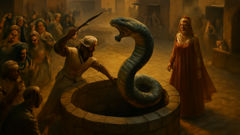
The strategy Bayajidda adopts is simple in design and sophisticated in implication. He knows he cannot simply chase the serpent from the well like a hunter driving off a fox. The creature's domain is the town's source of life. Its removal would leave a vacuum that others might fill unless the act is made public and symbolic. So Bayajidda prepares for a demonstration. He gathers allies—the queen's most trusted women, a handful of boys who can carry messages, and a few skeptical elders who are willing to test a new truth. They do not form an army; they fashion a spectacle. They rehearse the moment the way a chorus rehearses a line of song: who will lower the pail, who will roll the barrel, who will strike. The plan is meant to expose the mechanics of fear and to give the people a role in reclaiming their water.
When the day arrives, the square fills not with the hush of mourning but with a brittle electricity. Bayajidda stands at the rim of the well and addresses the crowd in measured words. He does not ask for a crown or belligerently declare himself a king. Instead he announces an act meant to change habit and expectation: he will enter the well and confront what has been making the town small. The queen chooses not to remain cloistered in court; though tradition prescribes otherwise, she walks among the people and watches. There is a tenderness in that choice—a recognition that leadership is not the opposite of vulnerability but its companion. That tenderness will lend legitimacy to Bayajidda's action.
The descent into the well is framed as ritual and as battle. Bayajidda brings with him instruments forged in distant places: a sword whose steel carries stories of other lands, a small pouch of salt for ritual cleansing, and a rope that will bind the serpent if the first strike does not kill it. He lowers himself where few have the courage to go, and the story slows as all good narratives do when lives are at stake. The serpent, confronted, rises from the blackness like history surfacing. It is sudden and massive, the kind of apparition that bends the spine of a crowd. Yet Bayajidda does not flinch. He moves with precise strikes and a kind of calmness born of someone who has made peace with the possibility of death. The fight lasts in some versions just one swift instant; in others it stretches in pulses of near-misses and sparks of blade on scale. Each detail is meaningful: the way Bayajidda's sword arcs, the way the women chant to steady one another, the way the queen does not look away.
When finally the serpent falls, the tale does not simply stop at the kill. The consequences unravel and reshape. There is a moment after triumph when silence becomes necessary; water spills and the people see the well's surface again, visible and usable. The symbolic act is completed when the town begins to draw water without fear. It is here that the queen's choice to ally with Bayajidda shows its depth: she offers him hospitality and access to the inner circle of power. In many versions of the legend she also grants him marriage. These acts are not mere romantic appendages of the story; they are political bargains. Marriage, in this narrative, is a fusion of reward and alliance. By taking the queen as partner Bayajidda becomes embedded in the social fabric of Daura, legitimized by the very woman whose authority he did not seize by force but amplified by deed.
The marriage is formalized with rites that bind lineage and land. The queen's court honors Bayajidda not as a conqueror but as a protector whose bravery reshaped the town's covenant with fear. This legal and symbolic act reconfigures succession and creates a platform for genealogies to be traced back to his act. The sons born of this union—some tellings say there were seven—go on to found other towns. This multiplication is central to the way the Hausa people narrate their own origin: one heroic act gives birth to multiple lineages, each carrying a piece of story and claim to authority. In that expansion the legend serves as both mythic explanation and social charter: it explains why different states trace their roots back to a single set of ancestors and why the names of those ancestors are invoked in questions of descent and right.
But the tale does not maintain an untroubled triumph. After the serpent's death there is a reordering that creates tension. Those who profited under the old regime—elders and functionaries who relied on rituals of tribute—resist. They craft counter-narratives about outsiders and the dangers of change. Some say Bayajidda's arrival brought new troubles, or that he left a quieter but no less firm claim on power that the queen could not always mitigate. Such dissent is part of the living myth: it acknowledges complexity rather than flattening the story into easy moral categories. The legend sustains itself by allowing these fissures; in them communities find ways to argue about lineage, leadership, and legitimacy for generations.
The confrontation with the serpent and the marriage to the queen are therefore more than plot points. They are a compressed lesson about courage as social practice: a bravery that requires planning, collective consent, and the willingness of leaders to change laws. Bayajidda's blade is important, but so is the queen's decision to share power, and the villagers' choice to refuse their old terror. When the well is used again, when the market's bustle returns with a new rhythm, the people of Daura carry the memory of what was negotiated at the rim of the well. That memory will be told and retold, given shape by griots and mothers and traders, until the story of a stranger and a queen becomes the story of many towns. It becomes an origin map, a set of names and places that stitch together a cultural identity across the Sahel.
In the next section the legacy of those sons and the institutions founded in the wake of Bayajidda's act will be traced, as the myth grows into genealogies and dynasties, and the living tradition of the Hausa states takes root in songs and law.
Dynasty, Diaspora, and Living Memory: How a Legend Became a People
When stories stretch across generations they begin to do things that simple events do not: they create kinship, provide legal frames, and offer naming structures that allow societies to talk about themselves. Bayajidda's sons, born of union with the queen of Daura and in some variants fathered elsewhere as well, are credited with the founding of the seven original Hausa states—Daura, Katsina, Kano, Zaria (sometimes called Zazzau), Gobir, Rano, and Biram. These are not only geographical claims; they are genealogical traces that allow people to situate origin and authority. Each town that claims descent from Bayajidda's line inherits both an ancestral story and a set of expectations about leadership, ritual, and social order.
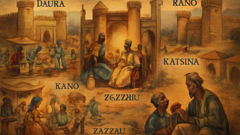
The mechanism by which myth becomes institution is instructive. In the years after the serpent, as Daura's markets grew and caravans threaded the town's lanes, the tale of Bayajidda was sung by griots and recited at naming ceremonies. Name, memory, and law became coterminous. New rulers invoked Bayajidda's name in their claims to legitimacy. When disputes over land or succession occurred, lineage claims tied to the Bayajidda myth were mobilized, not unlike how other cultures might reference ancient documents. This is the practical power of myth: it becomes a ledger for rights and a story-book of precedents. The legend thus graduated from an individual heroic episode into a legal and cultural backbone for many Hausa-speaking polities.
Migration and diaspora carried the story outward. As traders moved goods across the Sahel and the forest, they carried stories too—praise poetry, genealogies, and the memory of a man who claimed a well and a woman's hand. Merchants in Kano and potters in Rano told their children versions that favored the local founder. Over time local variants proliferated; some emphasized martial prowess, others the strategic intelligence of Bayajidda, and some elevated the queen's role far higher than in other tellings. This polyphonic nature of the myth allowed communities to claim parts of it while adapting it to local concerns. The multiplicity of versions is therefore not a problem but a sign of vitality: a single legend expanded into many voices.
The cultural work of the tale is also gendered. While Bayajidda is often foregrounded as the hero—the man who slew a serpent—many retellings insist that the queen's agency is indispensable. She is not a passive prize. She is the one who negotiates with elders, takes the risk of aligning publicly with an outsider, and reshapes the legal forms of the town by endorsing and legitimizing a new relationship. Thus, the legend encodes conversations about female power and the limits of authority. In oral tradition the queen sometimes speaks at length; in other versions her role is compressed into symbolic acts. Contemporary readers who look back may read her as a figure of proto-statecraft: a ruler aware that symbolic acts can reform institutions. The partnership she forms with Bayajidda marks a pragmatic recognition that leadership can be renewed when it allies courage with legitimacy.
The myth also interacts with historical forces. From the medieval trans-Saharan trade to the Islamic emirates that later shaped political life in the region, Bayajidda's tale sits at a cross-section of cultural flows. The legend predates and overlaps many historical layers, and as a result it has been woven into histories that also reckon with the spread of Islam, the rise of urban centers, and the formation of trading networks. Historians have debated the degree to which the Bayajidda cycle can be read as literal history versus symbolic narrative. But the more productive approach is to see the story as a cultural artifact that both reflects and shapes political memory. It helped communities name their past and guided political imagination when real-world rulers invoked the past to legitimize the present.
In the kitchens and courtyards of modern Hausa towns the legend remains lively. Mothers tell the story to bedtime children not as an archaic lesson but as a repository of values: courage, collective action, and the complexity of reward and cost. Street names, palace compounds, and festivals recall the names of Bayajidda's sons. Poets still call upon the episode at celebrations of leadership succession. The tale is also reinterpreted by modern writers who explore its psychological and social dimensions—probing issues of migration, cross-cultural marriage, and the negotiations that allow outsiders to be absorbed into local identities. In these reinterpretations the legend receives contemporary resonance: it speaks to migration in West Africa today, to questions of belonging and the ways communities embrace or resist newcomers.
The legacy of Bayajidda has not remained static. In colonial times, British administrators and travelers recorded local versions of the tale, sometimes misunderstanding its nuances. In the postcolonial period, scholars, artists, and community leaders reclaimed the narrative, using it to promote cultural heritage and civic education. The story's flexibility has made it a tool for education—as a way to teach younger generations about cooperation, the importance of confronting oppressive systems, and the value of alliances between different social actors. In museums and local festivals the tale is sometimes staged, bringing music, costume, and dance into dialogue with old lines of speech. The result is a living memory that refuses to be pinned down: it remains both local and regional, ancient and adaptable.
Yet the most enduring effect of the Bayajidda legend is its capacity to offer a model of social repair. The narrative says, in its quiet insistence, that acts of courage can be catalytic if they are coupled with communal consent. It insists that power is not merely seized but often legitimated by those who have been harmed. The queen's consent, the public nature of the serpent's death, and the subsequent naming of sons who would found towns are all parts of a sequence that ties valor to legitimacy. In that sequence the myth encodes a lesson: societal transformation requires both decisive action and communal acceptance.
In the present, as towns across the Hausa-speaking world negotiate modern challenges—urbanization, linguistic change, economic shifts—the Bayajidda story remains a touchstone. It is recited by elders and reimagined by young poets; it is used in classrooms to spark discussions on leadership and in theater to critique modern authority. Its ability to speak to both the small and the large—private courage and public institutions—is what anchors it. The legend survives because it contains a pathway for moral and political imagination: a story of a stranger, a queen, a serpent, and the many sons who carried that story forward into a people.
Conclusion
Stories like Bayajidda's endure because they do what history alone rarely does: they provide a language for communities to make sense of themselves. The legend is not a single fixed account; it is a conversation across generations about courage, legitimacy, and the costs of societal change. Bayajidda's slaying of the serpent is an act whose symbolism touches politics, gender, and the practicalities of everyday life—returning water to wells means returning choice and autonomy to people who had learned to accept terror as inevitable. The queen's choice to legitimize and ally with an outsider complicates easy narratives of conquest: it shows leadership as negotiation and recognizes the political potential of shared risk. The sons who spread into towns and founded states transform a single dramatic act into a web of memory and governance, demonstrating how myths can become the scaffolding of social order. In contemporary Hausa life the tale remains malleable, used to teach, to revise, and to imagine. It invites us to read myth as a living tool—capable of shaping law, inspiring art, and prompting reflection on migration, integration, and the meanings of bravery. Ultimately the Bayajidda story brings a simple yet durable message: that change is possible when courage is coupled with community, and that the origins of a people are often braided from both the startling deeds of individuals and the quieter, patient choices of those who choose to believe.

